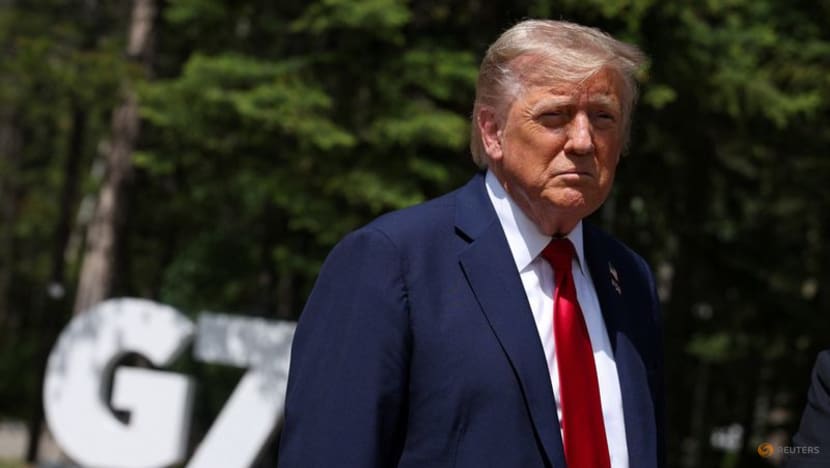Commentary: Asian leaders sidelined at G7 summit amid global turmoil
The G7 summit in Canada ended without a joint statement, emblematic of deepening fragmentation and uncertainty, says a political science professor.

OTTAWA, Canada: The G7 summit in Kananaskis, Canada, opened amid multidimensional crises. The summit epitomised the fragmentation and uncertainty that have come to characterise our age.
Host, Canada, along with most of the other G7 members and Asian invitees, were looking to forge a baseline consensus on stabilising trade and the global order, while accommodating US concerns for a more robust and self-reliant defence and security posture.
But events intervened. In the early hours of Jun 13, just prior to the summit’s opening, Israel began its anticipated and feared assault on Iran’s nuclear and security infrastructure. US President Donald Trump abruptly left the summit in the evening after its first day.
The anticipated one-on-one meetings with many of the participants (including those between Indian Prime Minister Modi and Australian Prime Minister Albanese and President Trump) never took place. Trump appeared pleased that the agenda was set around his tariff threats, viewing the other participants as mere supplicants.
Unable to meet up with Trump, Modi was deprived of an opportunity to represent the Global South in navigating shifts in global power dynamics. His participation was instead more important for restoring bilateral ties with Canada, which had been badly strained since the state-sponsored assassination of Khalistan separatists on Canadian soil.
In the end, there was very little opportunity to forge a common consensus, especially as the host and other participants were wary of confronting – and fearful of provoking – the US president.
MISSED OPPORTUNITIES
Perhaps the single outcome referencing Asia, though indirectly, was Trump’s meeting with UK Prime Minister Keir Starmer. The two leaders jointly unveiled the trade deal they had outlined earlier in Washington, but in addition, Trump pledged to safeguard AUKUS, despite the announcement of the Pentagon’s review of the deal.
The deal with the United Kingdom represents an outlying concession to Trump’s demands for tariffs. Not only did the United Kingdom concede a 10 per cent tariff, but it also agreed to swallow the 25 per cent tariff on steel and aluminium pending improvements in some vaguely defined future.
The United Kingdom agreed to cooperate in a game of prisoner’s dilemma, exposing all the other “prisoners” to a protectionist tariff baseline that other countries may be compelled to meet.
There was no time or room to reach a broader consensus on security to address the challenges posed by China and Russia. Issues like securing supply chains and critical mineral stockpiles were afforded little time in the discussion.
Newly elected South Korean President Lee Jae-myung never had the chance to meet Trump, while Japan made no progress in securing an economic security arrangement with the United States. Nikkei concluded that the Japanese Prime Minister had come away “empty-handed”. Trump, for his part, lamented the absence of Russian President Vladimir Putin, blaming former Canadian prime minister Justin Trudeau.
The opportunity to showcase the joint efforts of US allies to meet the security challenge – and in doing so, reinforce the framework of the global economy – slipped away, much like Trump himself. The summit ended without a comprehensive joint statement. Instead, the Canadian host had to make do with a Chair’s Statement.
The summit ended with six joint statements. The one on critical minerals failed to move much beyond the framework agreed to in 2023, despite the urgency of China’s recent retaliatory imposition of export controls.
Worthy but barely actionable initiatives on quantum computing and artificial intelligence served to dress up the relevance of the meeting, alongside a statement on combating wildfires – a topic particularly relevant to Canada and the province in which the summit was held.
A SNAPSHOT OF TURBULENT TIMES
The outcome of the summit in many ways belied the closing remarks by the host, Canadian Prime Minister Carney. Carney referenced the origins of the G7 fifty years ago at Rambouillet amid war in the Middle East, economic turmoil surrounding the end of Bretton Woods and stagflation resulting from the oil price shock of the Arab embargo.
He called for a new era of cooperation to overcome the current economic challenges and claimed this new era had been initiated. But overall, the summit ended without rising to the challenge.
There was little evidence that progress had been made in forging the “resilience” that Carney called for to combat such challenges as climate change. The “wildfire charter” joint statement – endorsed by Australia, India, the Republic of Korea and South Africa – fails to mention climate change.
This, as much as the failure to agree on a joint statement with respect to Ukraine and a statement on the Middle East that failed to call for an end to the fighting, points to the limited cooperation among putatively “like-minded” allies of the United States. The conclusion by one Canadian editorialist was that a G6 without the United States may have done more to advance international cooperation.
When the G7 began, its members accounted for 75 per cent of global GDP – they now account for 45 per cent. When it began, the United States accepted the initiative of French President Giscard d’Estaing to address turmoil in the global economy.
With the global economy again in turmoil – largely at the instance of US President Trump – the challenge is both to gain cooperation with the United States and to work cooperatively around the United States when required. On the evidence of this year’s summit, it is not clear that the G7 provides the framework to do both simultaneously.
This summit may be seen more as a snapshot of the turbulent times than as a landmark, let alone a turning point, in world affairs.
Jeremy Paltiel is Professor at Department of Political Science, Carleton University. This commentary first appeared on East Asia Forum.















